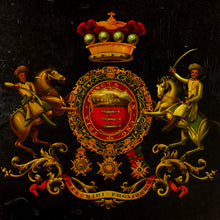Coach Panel of General Sir John Keane, 1st Baron Keane of Ghuznee, 1840
- Regular price
- £1,650
- Sale price
- £1,650
- Regular price
-
- Unit price
- /per
Adding product to your cart
Overall: 22.8cm x (8.9in) x 17.8cm (7in)
Polychrome coach panel displaying the arms of General Sir John Keane, 1st Baron Keane, commander of The Army of the Indus in the opening phase of the First Anglo-Afghan War (1839-1842) and in the 1840 campaign against the tribes of eastern Baluchistan. The arms of Keane (gules three salmons in pale argent) being augmented on a chief with a representation of the Fort of Ghuznee, surrounded by the motto of the Order of the Bath ‘Tria Juncta in Uno’ (Three united in one), encircled by the collars of a Knight Grand Cross of the Bath, the Hanoverian Royal Guelphic Order and the Afghan Order of the Doranee Empire. The shield and orders flanked by supporters (granted 22 August 1844) in the form of a Baluchi horseman to dexter with sword point downwards, and to sinister an Afghan horseman with sword point upward. The whole surmounted by a Baron’s coronet. Contained in period rosewood frame.
Read more
Concerns over creeping Russian influence in the spring of 1839 caused General Sir John Keane to lead a 20,000-strong British-Indian force, the Army of the Indus, through the Bolan and Khojak Passes into Afghanistan. The terrain was difficult, and Keane was harassed by frontier tribesmen en route. Keane entered Kandahar without a fight after its ruler, the brother of Dost Mohammed, fled to Kabul. Leaving a garrison at Kandahar under Major-General Sir William Nott, the main force then marched north-east towards Kabul. After negotiating with local warlords, the British also organised a triumphant entry into the Kandahar for Shah Shuja.
The route to Kabul was blocked by Ghuznee (or Ghazni) fort. This presented a major problem for Keane as he lacked the heavy artillery needed to breach its thick 60-foot-high walls. Nevertheless acting on intelligence from the political officer Captain Sir Alexander Burnes, the stronghold was taken by storm on 23 July 1839, for a cost of 200 British killed or wounded. The Afghans lost nearly 500 men, with another 1,600 captured. Ghazni was also well-supplied and its provisions eased the British advance on Kabul.
Dost Mohammed fled from Kabul and Emir Shah Shuja was duly installed in August. However, the British could not afford to keep troops in Kabul indefinitely. The countdown thus began to the humiliating retreat of 1842.
Lieutenant General John Keane, 1st Baron Keane (1781-1844) was the son of an Irish baronet and was commissioned Ensign at age 11. He rose to become Lieutenant-Colonel in the 60th Foot and commanded a brigade in the Peninsular War. For his services there, he was awarded the Army Gold Cross with two clasps for Martinique, Vitoria, the Pyrenees, Nivelle, the Nive, and Toulouse. Promoted to Major-General, he commanded the 3rd Brigade at the Battle of New Orleans where he was wounded twice. He served as commander-in-chief in the West Indies and also administered the colonial government of Jamaica. From 1834 to 1840 Lieutenant-General Keane was Commander-in-Chief of the Bombay Army. In February 1839, his forces seized Karachi. For his services in Afghanistan he was elevated to the peerage as Baron Keane, of Ghuznee and of Cappoquin in the County of Waterford on 23 December 1839. John Keane married twice, firstly to Grace Smith, daughter of Lieutenant General Sir John Smith, by whom he six whom he married in 1806, then secondly to Charlotte Maria Boland, the daughter of a Colonel Boland in 1840.






